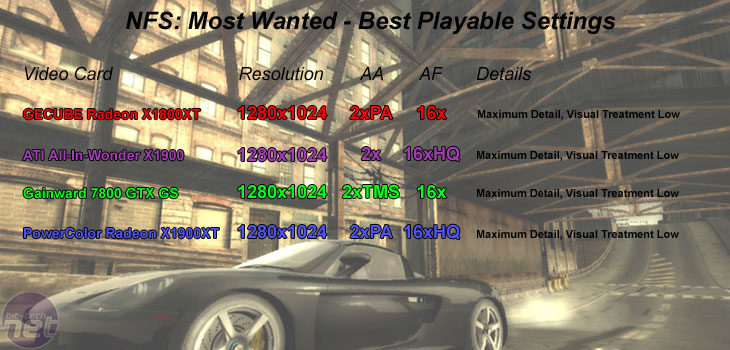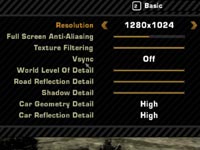Need For Speed: Most Wanted:
Publisher: Electronic ArtsWe used the full retail version of Need For Speed: Most Wanted - the latest addition to Electronic Arts' popular Need For Speed franchise. The game makes use of shaders everywhere, with realistic car reflections, a dynamic sky making use of HDR bloom and also weather patterns that change during the game. Most of the game takes place in the daytime, so aliasing is much more noticeable than it was in previous versions of the Need For Speed: Underground sub-franchise - antialiasing is preferred over a higher resolution in order to combat the edge aliasing.
There is a new setting called Visual Treatment which - when set to high - leaves a bright glow on most objects that get in the way of the sunlight. We feel this looks slightly unrealistic as the effect is over-used to an extent and it's best left set to the low setting with overbright enabled. Along with this, there's also the fact that the high setting causes a big performance drop, giving yet another arguement for leaving it on the lower setting.
We did a manual run through of the NFS World Loop sprint track that lasts for around 8 1/2 minutes. This is sufficient time to experience the rain effect and normal weather conditions in the same run through. The track gives a good idea of what NFS: Most Wanted will perform like on any card, as it goes around all regions of the world.
We found that the best playable settings in this game were when the average frame rate was above 40 frames per second, while the minimum was above 20 frames per second and the majority of the frames were rendered above 30 fps.


Performance adaptive AA didn't have the same frame rate implications as high quality anisotropic filtering on the X1800XT, so we felt that it was the best use of the horsepower available. It also made the game look look appreciably better too, because the NFS world already benefits from antialiasing and adaptive/transparency AA helps the foilage and trees look that little bit more realistic as well.
On the other hand, the All-In-Wonder X1900 didn't have enough memory bandwidth available to utilise performance adaptive AA. However, because of the way that R580 was designed, high quality anisotropic filtering is almost a given. The game was very smooth at 1280x1024 2xAA 16xHQ AF with maximum in-game details.
Gainward's GeForce 7800 GTX delivered the same kind of gaming experience as the GECUBE Radeon X1800XT, but with higher frame rates. Obviously, the GeForce 7800 GTX uses transparency antialiasing instead of adaptive AA, but all other settings remained the same on the two cards. However, the Gainward GeForce 7800 GTX had the performance advantage, with both higher average and minimum frame rates.

MSI MPG Velox 100R Chassis Review
October 14 2021 | 15:04








Want to comment? Please log in.